Parnassus concept artwork by Daniel Auber
Some interesting concept artwork and an interview with Parnassus' concept designer Daniel Auber.

Click to enlarge:
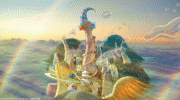
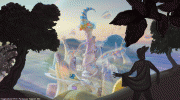

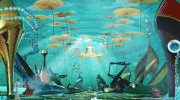
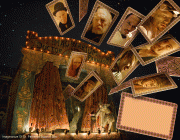
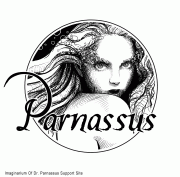
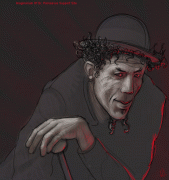
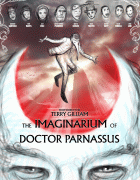
Theresa Shell: When you created (drew) Tony’s first Imaginarium, did you hand draw the image as a whole from the concepts sent to you by Dave Warren and Terry then scan and perfect it or did you create the entire thing on the computer from different images you drew yourself or sent you from Terry and Dave?
Daniel Auber: Dave and Terry would send me a pencil sketch they had in mind, with some photos of objects that could work as inspiration or reference for the colors and style of the image. Then I would start from a blank (digital) canvas and try to give shape to those suggestions creating an environment with a believable atmosphere and sense of space.
TS: That is not Heath hopping from lily pad to lily pad in this scene in the movie, is it? But, it IS him in this image, obviously.
DA: It was supposed to be Heath. In fact, in the concept design it was Heath because when I made it, it was supposed to be his character here. And, then it became Johnny’s scene.
TS: That’s what I thought. The features of the man in the movie just weren’t quite right to be Heath, I thought.
DA: That’s right.
TS: I also remembered the fact that you did all of your blue screen work after he had passed away.
DA: Exactly.
TS: That’s gorgeous. (Daniel now shows me each individual shoe in the picture as the actual shoes sit next to me on a table. We identify each and his rendition is incredible.)
Now, the lily pads, are they something you generated on the computer or were they also real.
DA: This is how it happens basically. I will show you the animatic. A 3D story board (animatic) is generated on the computer where exactly camera movement is planned. So, in the room with the blue screen they shoot the actors and nothing else. There was only actors and blue screen. But, the cameras were moving in particular ways so that afterward, in post production, we would generate, with the computer, every element, the shoes, the water, the lily pads and everything.
For example, for the shoes, I took pictures of six sides of the shoes so the computer people, the animators, and the computer model makers could create exactly each shoe with the perfect proportions. You can also see in the movie, Jerome C. Rousseau’s label in one of the shoes. Amy made sure that Jerome’s name was there. So everything is done in 3D basically. What we see there on the screen is generated synthetically, but the shoes’ proportions came from pictures and the other elements are computer generated. But, the first thing is the concept design. Then when the color palette and the geography, the map is defined, then the computer people would create all the big objects and elements, just roughly. Then much more before the animation they study. They decide movement and when every camera movement is decided they go and shoot it with the real actors on a blue screen. The same camera movement, only with the actors.
TS: Nicola told me that the schedule was so tight and the budget so strained that you guys usually had to do it first time out and that a lot of times you would just have to go from set to set and that it was really hard on all of you. I can see why it is so important to have everything mapped out to the letter.
DA: Absolutely.
We are again looking at the full resolution original concept art for this first Imaginarium.
TS: That’s incredible. (The image is exquisite and clearly shows every tiny detail that is in the movie, including the lighting of the scene.)
DA: Now, this is the color palette.
TS: Who chooses the color palette?
DA: I do. I choose it by putting together a bit of everything from the reference imagines they (Terry Gilliam and Dave Warren) sent me. All my work, in this case, was a digital creation because it is all original. So, before they start shooting the scene with the actors I need to tell them exactly what kind of light they are going to have to use for the actors because they are going to have to match the light for the actors with the light in this image. So, once I draw this one, Peerless makes this (he shows me the 3D animatic of the light for the scene), so that Nicola, the director of photography can make his suggestions as to what light to put on the actors. They will film the actors with this light and they will be sure that, when the actors are added on the digital scene, everything will feel organic. The actors will have the necessary light.
Daniel now brings up the full resolution image of the scene of Dr. Parnassus and his wife in the gondola. Percy is the gondolier and to the far right of the image, Mr. Nick is fishing in the river of dead cows with his pant legs rolled up.
TS: What a beautiful likeness of Percy as the gondolier. Was Tom Waits not incredible as Mr. Nick?
DA: Yes, yes, he was.
Daniel now plays the 3D animatic of this scene with the gondola in the river of cows. It’s amazing.
DA: This concept design was made for Nicola, again for the light, for the atmosphere. On one side they could shoot the actors and on the other side they could do the 3D environment. For it to flow right it is given to the computer people to decide the color and movement. It (the animatic) is before shooting the actors, before everything. Now they are deciding how the scene is going to move; the actors and everything. It’s like a moving storyboard basically. Everything has to be detailed, planned and plotted. It’s got to be digital if you want it to be exactly what you want to see. So, after it’ has been computer generated it can go on the blue screen with the gondola (which is real and on the soundstage as described above) and they will shoot this gondola movement with the blue screen with the actors. Then they will put it together, the actors with the CG background and the elements.
TS: Now some of the photos Nicola sent me are falling into place because he sent some some photos from the filming of this scene with the blue screen. There was a photo of just the bare gondola and this crazy little thing that looked like a fan with weeds hanging from it that helped the gondola look like it was moving. So, now that you tell me how it is all put together, it makes sense.
DA: Exactly. Yes.
TS: Back to the first Imaginarium scene, you used actual photos of Jerome C. Rousseau’s shoes and not drawings in the scene.
DA: Right. The scene is a mixture of photographs and drawings.
TS: So you basically positioned the shoes onto your art for the scene and erased their background.
DA: Yes.
TS: Then you put in all the other elements.
DA: Yes. Here, I’ll show you the layers.
Daniel takes the entire piece of artwork apart for me layer by layer, showing me why he put different elements facing at particular angles so that they would shows correctly in the light he had created for the scene and more. He takes the photo down to individual elements and rays of light for me
TS: How long did you work on this one picture?
DA: It took several weeks to create it and get all of the elements and angles right. See the way the light is on every object? Then I add the earrings, the buckles and other elements and make it into one layer.
TS: It’s amazing to me that in your mind’s eye you had this complete image and that layer by layer on a blank (digital) canvas you put it into one final image. To me, I would look at it and try to put them all together at one time in one image. Which would of course be disastrous.
More info at the source

Click to enlarge:








Theresa Shell: When you created (drew) Tony’s first Imaginarium, did you hand draw the image as a whole from the concepts sent to you by Dave Warren and Terry then scan and perfect it or did you create the entire thing on the computer from different images you drew yourself or sent you from Terry and Dave?
Daniel Auber: Dave and Terry would send me a pencil sketch they had in mind, with some photos of objects that could work as inspiration or reference for the colors and style of the image. Then I would start from a blank (digital) canvas and try to give shape to those suggestions creating an environment with a believable atmosphere and sense of space.
TS: That is not Heath hopping from lily pad to lily pad in this scene in the movie, is it? But, it IS him in this image, obviously.
DA: It was supposed to be Heath. In fact, in the concept design it was Heath because when I made it, it was supposed to be his character here. And, then it became Johnny’s scene.
TS: That’s what I thought. The features of the man in the movie just weren’t quite right to be Heath, I thought.
DA: That’s right.
TS: I also remembered the fact that you did all of your blue screen work after he had passed away.
DA: Exactly.
TS: That’s gorgeous. (Daniel now shows me each individual shoe in the picture as the actual shoes sit next to me on a table. We identify each and his rendition is incredible.)
Now, the lily pads, are they something you generated on the computer or were they also real.
DA: This is how it happens basically. I will show you the animatic. A 3D story board (animatic) is generated on the computer where exactly camera movement is planned. So, in the room with the blue screen they shoot the actors and nothing else. There was only actors and blue screen. But, the cameras were moving in particular ways so that afterward, in post production, we would generate, with the computer, every element, the shoes, the water, the lily pads and everything.
For example, for the shoes, I took pictures of six sides of the shoes so the computer people, the animators, and the computer model makers could create exactly each shoe with the perfect proportions. You can also see in the movie, Jerome C. Rousseau’s label in one of the shoes. Amy made sure that Jerome’s name was there. So everything is done in 3D basically. What we see there on the screen is generated synthetically, but the shoes’ proportions came from pictures and the other elements are computer generated. But, the first thing is the concept design. Then when the color palette and the geography, the map is defined, then the computer people would create all the big objects and elements, just roughly. Then much more before the animation they study. They decide movement and when every camera movement is decided they go and shoot it with the real actors on a blue screen. The same camera movement, only with the actors.
TS: Nicola told me that the schedule was so tight and the budget so strained that you guys usually had to do it first time out and that a lot of times you would just have to go from set to set and that it was really hard on all of you. I can see why it is so important to have everything mapped out to the letter.
DA: Absolutely.
We are again looking at the full resolution original concept art for this first Imaginarium.
TS: That’s incredible. (The image is exquisite and clearly shows every tiny detail that is in the movie, including the lighting of the scene.)
DA: Now, this is the color palette.
TS: Who chooses the color palette?
DA: I do. I choose it by putting together a bit of everything from the reference imagines they (Terry Gilliam and Dave Warren) sent me. All my work, in this case, was a digital creation because it is all original. So, before they start shooting the scene with the actors I need to tell them exactly what kind of light they are going to have to use for the actors because they are going to have to match the light for the actors with the light in this image. So, once I draw this one, Peerless makes this (he shows me the 3D animatic of the light for the scene), so that Nicola, the director of photography can make his suggestions as to what light to put on the actors. They will film the actors with this light and they will be sure that, when the actors are added on the digital scene, everything will feel organic. The actors will have the necessary light.
Daniel now brings up the full resolution image of the scene of Dr. Parnassus and his wife in the gondola. Percy is the gondolier and to the far right of the image, Mr. Nick is fishing in the river of dead cows with his pant legs rolled up.
TS: What a beautiful likeness of Percy as the gondolier. Was Tom Waits not incredible as Mr. Nick?
DA: Yes, yes, he was.
Daniel now plays the 3D animatic of this scene with the gondola in the river of cows. It’s amazing.
DA: This concept design was made for Nicola, again for the light, for the atmosphere. On one side they could shoot the actors and on the other side they could do the 3D environment. For it to flow right it is given to the computer people to decide the color and movement. It (the animatic) is before shooting the actors, before everything. Now they are deciding how the scene is going to move; the actors and everything. It’s like a moving storyboard basically. Everything has to be detailed, planned and plotted. It’s got to be digital if you want it to be exactly what you want to see. So, after it’ has been computer generated it can go on the blue screen with the gondola (which is real and on the soundstage as described above) and they will shoot this gondola movement with the blue screen with the actors. Then they will put it together, the actors with the CG background and the elements.
TS: Now some of the photos Nicola sent me are falling into place because he sent some some photos from the filming of this scene with the blue screen. There was a photo of just the bare gondola and this crazy little thing that looked like a fan with weeds hanging from it that helped the gondola look like it was moving. So, now that you tell me how it is all put together, it makes sense.
DA: Exactly. Yes.
TS: Back to the first Imaginarium scene, you used actual photos of Jerome C. Rousseau’s shoes and not drawings in the scene.
DA: Right. The scene is a mixture of photographs and drawings.
TS: So you basically positioned the shoes onto your art for the scene and erased their background.
DA: Yes.
TS: Then you put in all the other elements.
DA: Yes. Here, I’ll show you the layers.
Daniel takes the entire piece of artwork apart for me layer by layer, showing me why he put different elements facing at particular angles so that they would shows correctly in the light he had created for the scene and more. He takes the photo down to individual elements and rays of light for me
TS: How long did you work on this one picture?
DA: It took several weeks to create it and get all of the elements and angles right. See the way the light is on every object? Then I add the earrings, the buckles and other elements and make it into one layer.
TS: It’s amazing to me that in your mind’s eye you had this complete image and that layer by layer on a blank (digital) canvas you put it into one final image. To me, I would look at it and try to put them all together at one time in one image. Which would of course be disastrous.
More info at the source